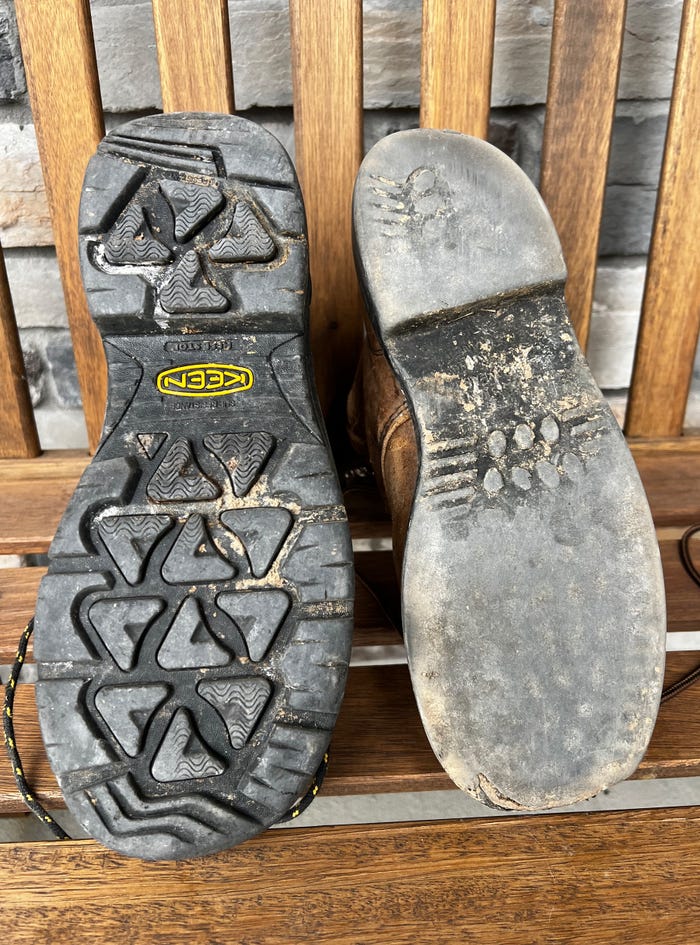December 6, 2023

Editor’s note: This is the first installment of a new column about farm safety and wellness, written by the experts at the University of Nebraska Medical Center’s Central States-Center for Agricultural Safety and Health. There will be a new column each month tackling timely health, safety and wellness issues to keep farmers and ranchers healthy, in the field and going strong. The Spanish version of this same article is available through a link at the end to a downloadable and printable PDF format.
by Ellen Duysen
From the invisible black ice outside the shop door to the slick manure coating on the cattle shed floor, there are endless opportunities for our footwear to lose traction with the surfaces we are walking on, resulting in our feet in the air, instead of the ground.
The Centers for Disease Control reports that 800,000 people are hospitalized yearly because of falls. Tragically, some falls will result in death. It is worth exploring ways to avoid falls in slippery conditions.
Choosing the proper footwear for agricultural work is crucial, even when working in ideal conditions. In wet, slick and slimy conditions, what we choose to put on our feet in the morning may mean the difference between completing a good day’s work or recovering in the hospital.
8 tips for better footwear
Consider the following eight features when choosing your next pair of safe footwear:
1. Traction. For work in slippery conditions, look for boots with deep treads and slip-resistant designs on the soles. Go ahead and say goodbye to those boots with no tread.
2. Ankle support. Good ankle support can reduce the risk of ankle sprains and other injuries.
3. Water and chemical resistance. Your choice of footwear should depend on the jobs you will perform and the weather conditions. Choose water-resistant footwear in wet conditions. Use unlined rubber boots when handling chemicals and pesticides.
4. Easy to clean. Treads full of debris result in reduced traction, so choose treads that will be easy to clean out. Clean them often.
5. Comfort. Shoes with arch support and good cushioning will reduce foot fatigue. Consider a boot made with advanced materials that are stronger and lighter, including Kevlar fiber for strength, nitrile for heat resistance and new abrasion-resistant leather to prolong the life of your boots.
6. Toe protection. To keep your toes warm and safe, consider composite versus steel toe caps on your boots for winter-weather use. Innovations include a more comfortable ergonomic steel toe box design.
7. Breathability. Mesh panels can reduce sweating and keep your feet cooler in the summer.
8. Side-zip and pull-on boots. Wearing boots without laces can help to eliminate tripping and entanglement hazards.
After finding the perfect shoe or boot for the job, consider a few other tips to help you stay upright while working, such as using attachable ice cleats on the soles of your footwear to provide additional grip on icy surfaces. Taking small, deliberate steps like a penguin when walking on icy or slippery surfaces will reduce the risk of slipping.

WIDOW MAKER: It isn’t difficult to decipher which shoe has more traction on ice and snow. If you’ve ever lost your feet on the ice and hit your head or limbs on the frozen ground on the way down, you know that traction is a key factor in proper winter footwear.
Using the handrail on stairs and equipment will provide a point of contact to help you maintain balance and catch yourself. Keeping your head up, eyes forward, and avoiding distractions like texting or talking on the phone while walking will help to keep you on your feet.
Preventing slips and falls while working in agriculture involves wearing the appropriate footwear, being aware of environmental conditions, and, of course, using great caution in wet, slippery and slimy conditions.
Duysen is a research assistant professor at the UNMC College of Public Health and is coordinator of CS-CASH.
For the Spanish version pdf of this same article, click here.
Read more about:
Farm SafetyYou May Also Like




